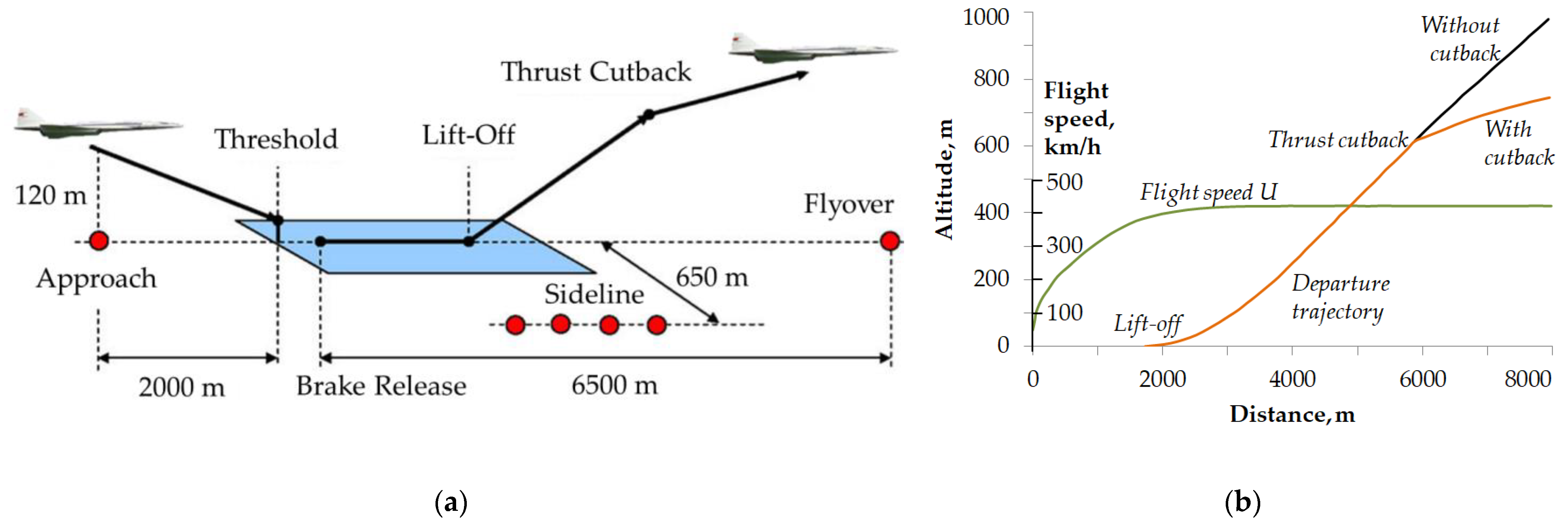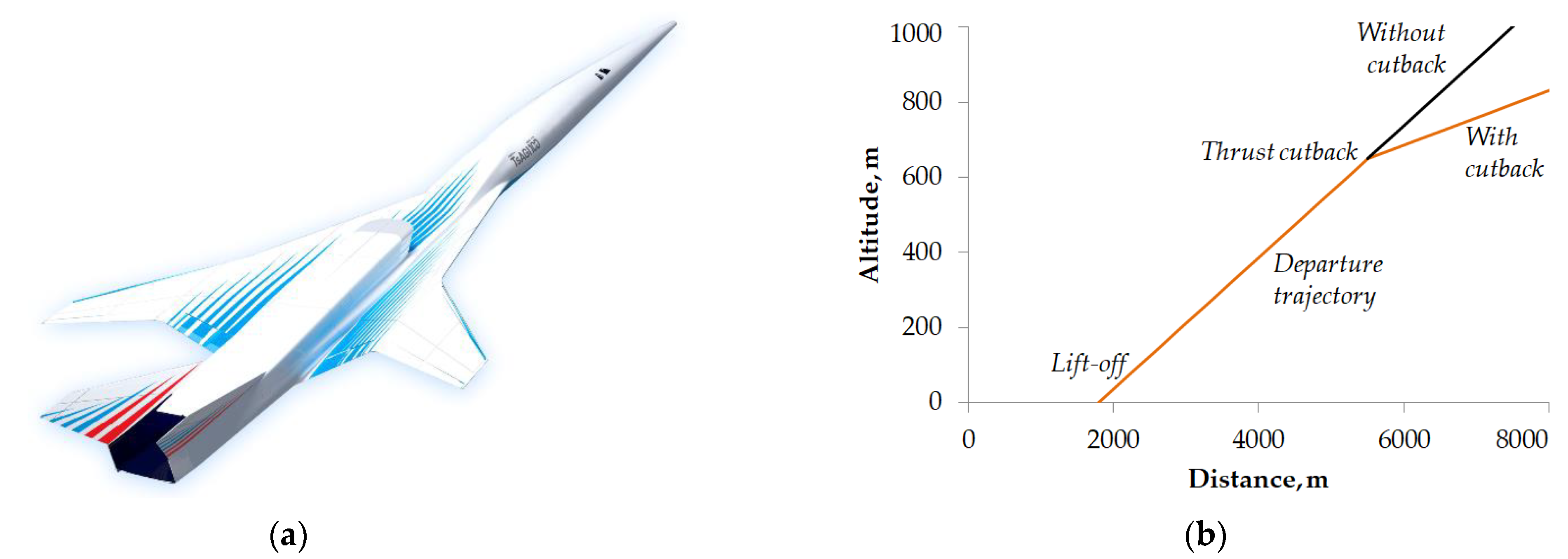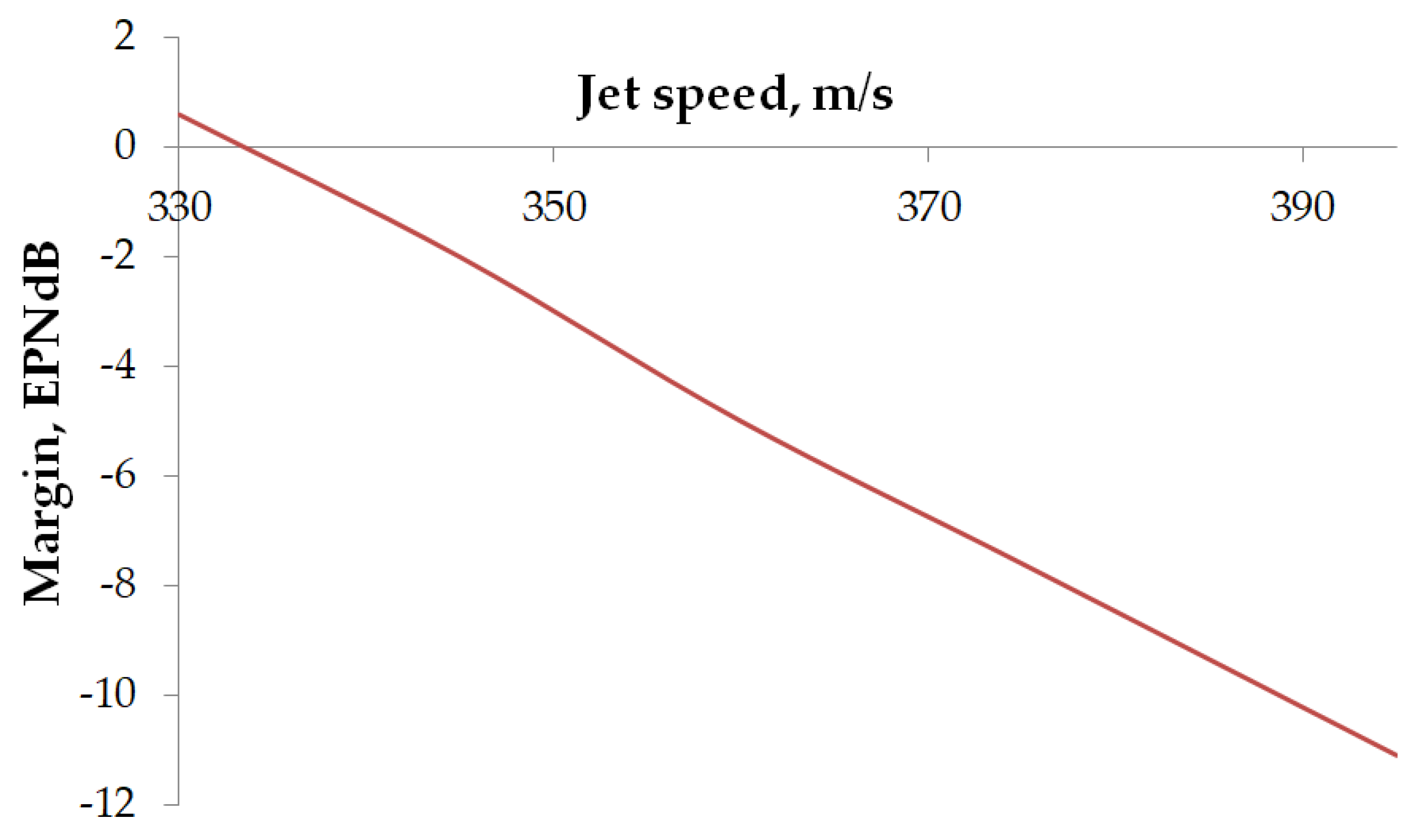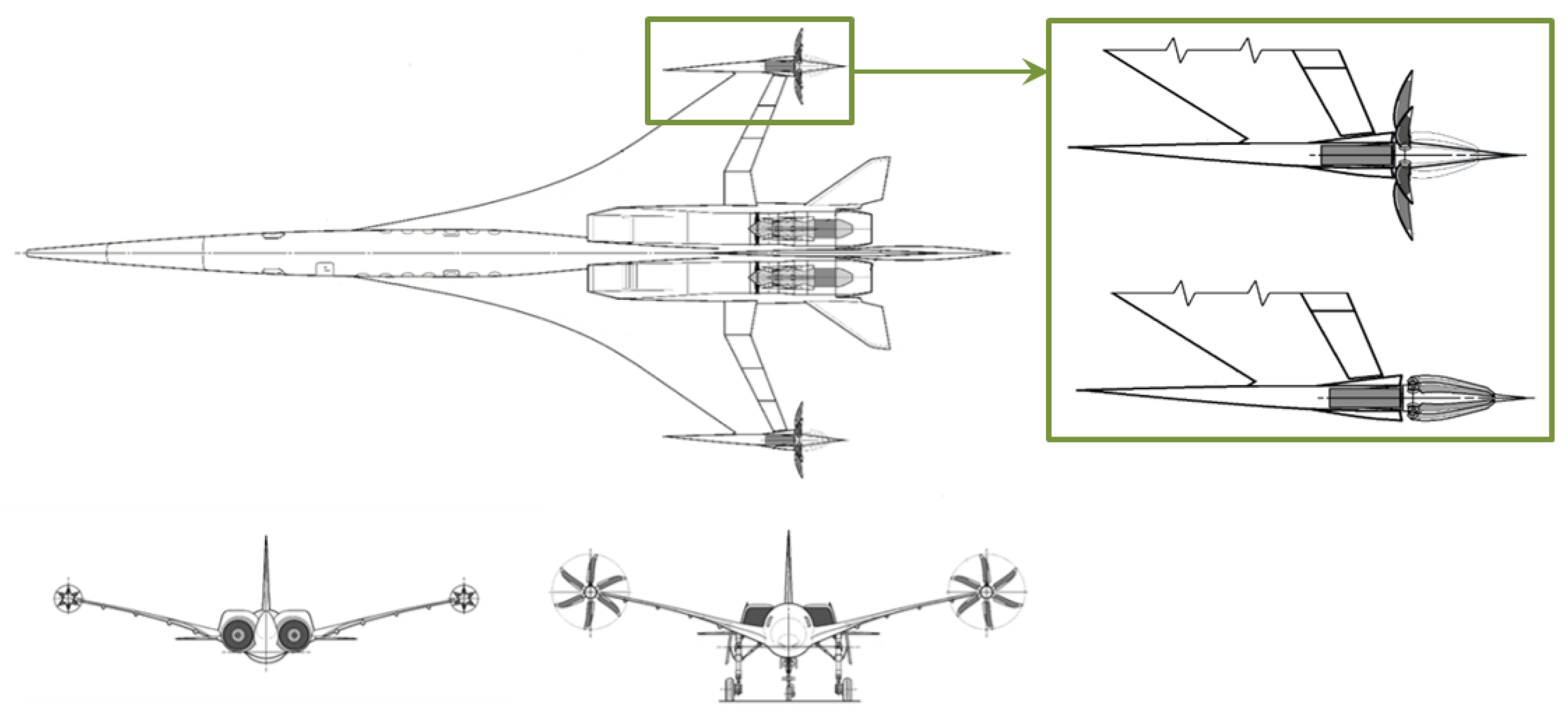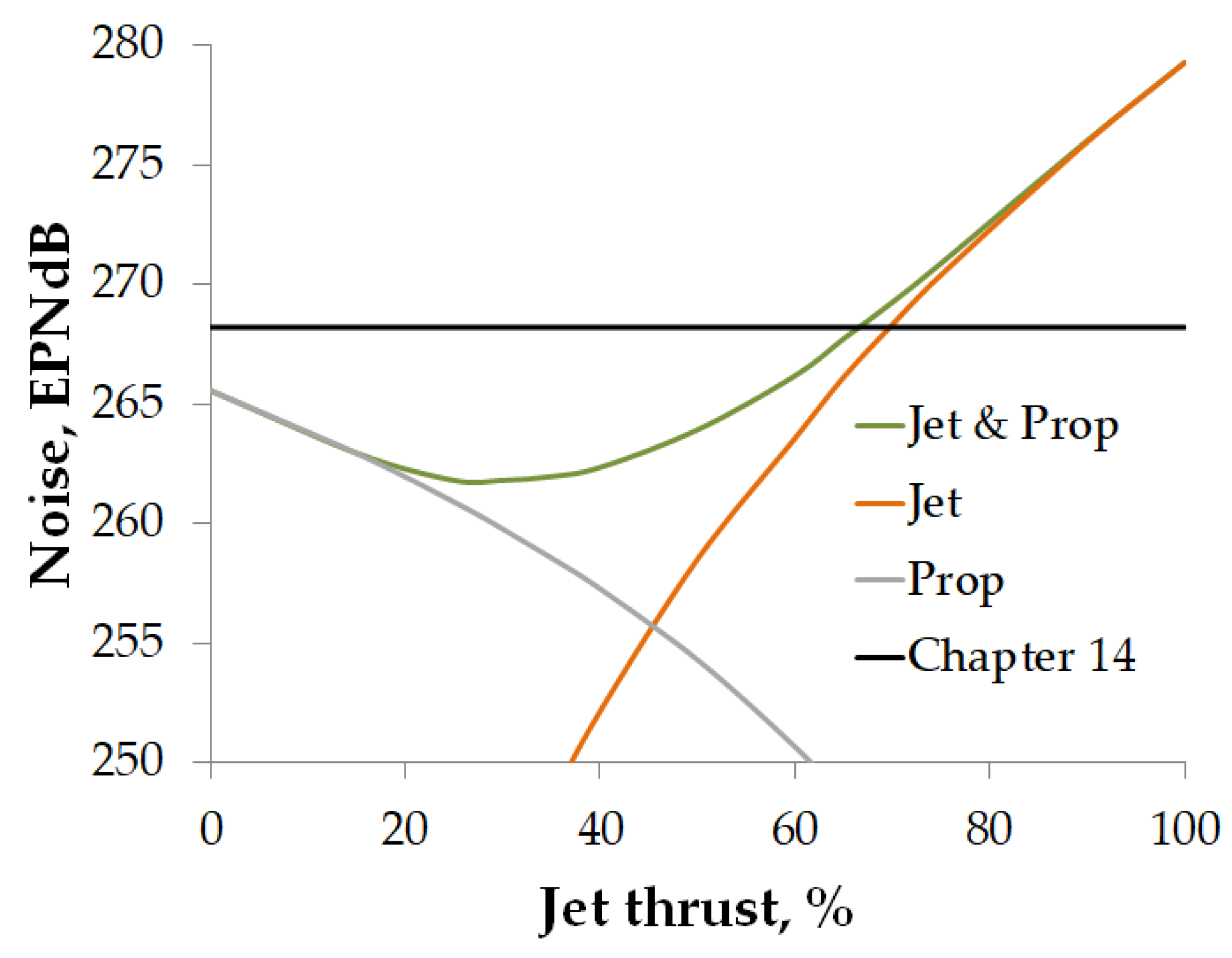1. Introduction
The era of supersonic civil aviation began on 31 December 1968 with the maiden flight of a Soviet Tupolev-144 from Zhukovsky, Russia and ended on 26 November 2003 with the final flight of a British–French Concorde to Filton, UK and the following retirement of the aircraft. Although there are no supersonic civil aircraft in operation at the moment, the vision of resumed supersonic passenger flights continues to encourage scientists and engineers to develop novel supersonic flight vehicles. However, future supersonic civil aircraft have to meet new challenges that were not so prominent for Tupolev-144 and Concorde at their design stage; one of most important among them is compliance with environmental protection regulations, in particular, community noise requirements, which became impressively more stringent from the time of 1960s–1970s. Another environmental issue specific to supersonic aircraft is their sonic boom; the sonic boom levels that the general population agrees to tolerate have decreased markedly from the time of development of the first-generation supersonic civil aircraft. Although low levels of sonic boom are imperative for supersonic civil aircraft, in this paper we address only the former problem, i.e., community noise.
Community noise is quantified by noise certification regulations that require aircraft to have noise levels at three certification points (takeoff, flyover, and approach) lower than some specified values in the EPNL metric. For modern subsonic aircraft, the noise level values are described in Chapter 14 of Volume I Annex 16 ICAO, and although next-generation supersonic aircraft are not yet subject to these requirements, the population expects them to be as quiet as their modern subsonic counterparts, i.e., complying with the norms of Chapter 14.
As a result, community noise turns out to be a strong constraint for the novel concepts of supersonic civil aircraft, because the advances in noise reduction for subsonic aircraft and their engines originated from their remarkable evolution over the last half-century; for instance, modern subsonic aircraft are powered by the turbofan engines with dramatically higher bypass ratios (BPR = 8.5 for PD-14, 12.5 for PW1100G, etc.) than those of the engines from 1960s (BPR = 0.3 for Rolls-Royce Conway 508, 1.0 for NK-8, etc.). Higher bypass ratios mean lower jet speeds and, therefore, significantly lower jet noise levels, which are proportional to the eighth power of the jet speed in accordance with Lighthill’s theory [
1]. Consequently, jet noise, which has been a dominant noise source for engines with low bypass ratios, is so reduced for high-bypass-ratio engines that for modern airliners it is often overcome by other noise sources such as fan noise, airframe noise, and interaction noise.
However, this evolution path of increasing bypass ratios looks like a dead end for supersonic vehicles, because high-bypass-ratio engines would greatly deteriorate aerodynamic performance of an aircraft during cruise at supersonic flight speeds, making such an aircraft configuration economically unviable. Indeed, there are estimates that bypass ratios beyond 3.0 would hinder the aircraft to efficiently pass the transonic regime and would lead to unacceptably poor performance at supersonic cruise [
2]. As a result, although concepts of future supersonic civil aircraft tend to use engines with the maximum bypass ratios allowed by the aerodynamic considerations, the bypass ratios are still low to moderate.
This makes jet noise a dominant noise source for supersonic aircraft, and although there are several other noise sources that contribute to the total noise levels, it is the turbulent jet that appears most problematic for supersonic vehicles, because at present there are no effective methods of jet noise reduction other than decreasing jet speed, which implies increasing the bypass ratio of the engines to compensate for the thrust and is constrained by aerodynamic requirements, as discussed above. There are other available methods of jet noise reduction, which are reviewed in [
3,
4] and include such technologies as nozzle shape modifications [
5,
6] or active noise control [
7,
8,
9], but they are not technologically mature or efficient enough.
Unlike the turbulent jet, the other noise sources of supersonic aircraft (fan noise, airframe noise, etc.) can be significantly mitigated with the existing methods of noise reduction. For example, concepts of next-generation supersonic aircraft often have engines with longer inlet ducts that are located above the airframe; these features allow fan noise to be reduced with acoustic liners inside engine ducts [
10] and with noise shielding by the airframe [
11]. During approach and landing, the engines are throttled down so that airframe noise, i.e., noise due to flow around landing gears, high-lift devices, and other airframe elements, can become an important noise source. Nevertheless, because of its strong dependence on the flight speed, airframe noise can be effectively reduced by decreasing the approach speed of the aircraft. Moreover, there are different methods of airframe noise reduction, both passive and active [
12], that can be used to further reduce airframe noise. Therefore, although mitigation of these noise sources constitutes a formidable scientific and technical problem, major advances in its solution can be expected, so that jet noise will continue as a dominant noise source for supersonic civil aircraft with low-to-moderate-bypass-ratio engines.
As a result, jet noise sets the lower limit and a reference point for the noise levels of a given supersonic aircraft. On the one hand, lacking effective methods of jet noise reduction, it is unlikely that the aircraft will have noise levels below the limit. In other words, if the noise levels based on aircraft engine jets exceed the noise requirements, then the aircraft will definitely fail to comply with the noise regulations when the other noise sources are accounted for. On the other hand, having effective methods of noise reduction for the other noise sources, it is likely that their contribution to the total aircraft noise will be reduced by applying appropriate practices, so that the total noise will be close to the estimations based on the jet noise source alone. Therefore, estimations of the allowable jet speed limit do not just constitute a theoretical minimum for aircraft noise; they are realistic enough when the modern methods of noise reduction are applied to all noise sources for supersonic civil aircraft with low-to-moderate-bypass-ratio engines. Such assessments are particularly useful at the early stages of the aircraft design process, enabling selection of the aircraft configuration that can, at least in principle, comply with the noise regulations. The present study applies this approach to a concept of next-generation supersonic civil aircraft and estimates its noise levels, as well as the jet speed limit that allows the aircraft to comply with the norms of Chapter 14 while meeting aerodynamic requirements on thrust, flight speed, and trajectory. In addition, a novel concept of supersonic aircraft is proposed and studied that allows decreasing jet speed without necessarily increasing bypass ratio of the engines. The missing part of the thrust is obtained from another source. The paper is organized as follows. In the next Section, the approach to noise level prediction based on jet alone is validated by application to Tupolev-144, where the prediction results are compared with the available experimental noise data. In
Section 3, the approach is applied to a concept of next-generation supersonic civil aircraft; its noise levels and the required jet speeds for the aircraft are determined. Based on these results, a novel evolution path for future supersonic aircraft is proposed in
Section 4, which describes a concept of supersonic aircraft that meets the requirements of Chapter 14.
2. Jet Contribution to Tupolev-144 Noise Levels
Let us consider the method of estimation of aircraft noise based on jet noise source alone in application to the supersonic civil aircraft for which experimental data on its noise levels are available, such as for Tupolev-144. For Tupolev-144, the noise levels at the certification points can be found in [
13].
The location of certification points at takeoff, flyover, and approach are schematically shown in
Figure 1a. It should be noted that they correspond to the requirements of Chapter 2 of Volume I Annex 16 ICAO, because it is this Chapter that was then in effect. As a result, sideline microphones that measure noise at takeoff were installed at the distance of 650 m from the trajectory; this distance was reduced to 450 m in the later Chapters (Chapter 3, Chapter 4, and current Chapter 14). Noise at takeoff is determined as the maximum noise level at these sideline microphones; noise at flyover and approach is measured by single microphones in the corresponding points as shown in
Figure 1a.
As discussed in Introduction, we assume that the noise of the aircraft is determined by its jets; their parameters during departure and approach are provided in
Table 1. Departure trajectory is shown in
Figure 1b; at approach, the standard trajectory with 3° slope is used.
Jet noise is calculated according to SAE ARP 876D. The accuracy of SAE ARP 876D for jet noise prediction was analyzed recently in [
14] and exhibited robust and appropriate prediction results for jet noise. Since the jets are supersonic during departure and approach (their Mach number (
M) > 1), the additional noise source associated with shocks (so-called BBSAN—Broadband Shocks Associated Noise [
15]) is also included in the jet noise calculations according to SAE ARP 876D.
The EPNdB levels in the certification points are obtained with SOPRANO software [
16], which was developed within the framework of EU SILENCE(R) project as a common tool to compare different technologies in terms of their effect on community noise. TsAGI performed a validation study of SOPRANO software through comparisons with the results of its own in-house code and experimental data, which showed a good agreement. In application to supersonic aircraft, TsAGI used SOPRANO for calculating noise of a Supersonic Technology Concept Aeroplane (STCA) developed by NASA ([
17], p. 40); the obtained noise estimates agreed with those provided by NASA and JAXA.
Effects of atmospheric absorption (SAE ARP 866A), lateral attenuation (SAE AIR 1751), and ground reflection [
18] are included in the calculation scheme. The results of EPNL calculations for Tupolev-144 at the certification points are provided in
Table 2 and compared with the experimental data and the requirements of Chapter 2.
It can be seen that the results of calculations are quite close to the experimental data (within the range of 1 EPNdB); this encouraging agreement between the results shows that it is the turbulent jet that determines the noise of this aircraft at all three certification points. This allows us to use this approach of noise calculation for other supersonic aircraft as well, with the same assumptions. Comparison with the requirements of Chapter 2 shows that Tupolev-144 exceeded the noise levels for subsonic aircraft at all certification points with a large margin.
3. Noise Levels of Next-Generation Supersonic Aircraft Concept
As noted above, the experience in designing the first-generation supersonic civil aircraft (Tupolev-144 and Concorde) showed that their main sources of community noise are the high-speed jets. For the next-generation aircraft concepts, engines with higher bypass ratios up to BPR = 3.0 are considered. This allows jet speed to be reduced significantly, from 800 m/s down to 350–400 m/s, with the corresponding reduction of the noise levels. We will discuss later whether such a reduction is sufficient and what can be done if this is not enough.
Let us consider as an example a concept of next-generation supersonic aircraft developed by TsAGI [
19] to assess the allowable jet speed that makes it possible for the aircraft to comply with noise requirements of Chapter 14. A general view of the supersonic civil aircraft concept is shown in
Figure 2a. It is a business jet with the maximum takeoff mass (MTOM) of 56 tons, powered by two engines with bypass ratio (BPR) of 2.5 at takeoff. The aircraft has a seating capacity of eight passengers and is designed for the cruise speed of
M = 1.8 and flight range of 7400 km. The departure trajectory of the aircraft is shown in
Figure 2b.
The turbulent jet will be considered as a dominant noise source of the supersonic aircraft in the same manner as has been done in
Section 2 for Tupolev-144. Parameters of the turbulent jet for the aircraft during departure and approach are provided in
Table 3. In should be noted that unlike Tupolev-144, the jets for this supersonic aircraft are subsonic during departure and approach (their Mach number (
M) < 1).
The same calculation scheme as in
Section 2 for Tupolev-144 is used here for determining noise levels at the certification points for the next-generation supersonic civil aircraft, with the difference that the distance to sideline microphones is set to 450 m. The results of these calculations are summarized in
Table 4 and compared with the requirements of past Chapter 3 and current Chapter 14 for subsonic aircraft.
As illustrated in
Table 4, the limit of Chapter 14 for the maximum noise level at each of the three certification points is 1 EPNdB below the maximum noise level permitted by Chapter 3. Moreover, the limit of Chapter 14 for cumulative (total) noise, which is defined as an arithmetic sum of EPNdB noise levels at all three certification points, is 17 EPNdB below the cumulative noise permitted by Chapter 3.
From
Table 4, it can be seen that for the next-generation supersonic civil aircraft the noise levels calculated by the jets alone fulfill the requirements of Chapter 14 at all certification points. Cumulative (total) noise, which is defined as an arithmetic sum of EPNdB noise levels at three certification points, meets the requirements of Chapter 14 with the margin of 1.1 EPNdB.
Nevertheless, one should note that the calculated noise level at approach is strikingly low; it is less than Chapter 14 requirements by a margin of 12.2 EPNdB. For comparison, one can mention that the quietest modern subsonic aircraft with MTOM = 56 tons (Embraer E190-E2, powered by two turbofan engines with BPR = 12) has the noise level 91.4 EPNdB at the approach certification point. It appears extremely unlikely that the noise of the supersonic aircraft at approach will be 5 EPNdB less than the noise of the quietest subsonic aircraft with the same MTOM. A reasonable explanation for this low noise level is that at approach, the jet of the considered aircraft has a rather low speed, so that the other noise sources (fan noise, airframe noise, etc.) produce noise levels similar or even exceeding the noise levels of the low-speed turbulent jet. Since the contributions of these noise sources are not accounted for in the calculations in
Table 3, this leads to the underprediction of noise level specifically at approach.
Therefore, calculations of noise levels at approach have to include all noise sources of supersonic aircraft, which significantly complicates the calculation scheme, especially at the early design stage when a number of required parameters of the powerplant and airframe can still be undefined. A simpler method would be to use the noise level of an analogous subsonic aircraft at approach as a reference value for the noise level for the supersonic aircraft; however, it is unclear how to select the analogous subsonic aircraft. The choice of the reference subsonic aircraft can have major implications for cumulative noise assessment, since noise levels at approach for the subsonic aircraft with MTOM = 56 tons lie within a wide range from 91.4 EPNdB for Embraer E190-E2 to 100.1 EPNdB for Boeing 737-300.
For the purpose of the present study, the approach noise level of the supersonic aircraft is set equal to the requirements of Chapter 14 at the approach certification point. The idea behind such a choice is that if the approach noise level is higher than the Chapter 14 requirements, the aircraft will definitely fail to comply with Chapter 14. Therefore, the Chapter 14 requirements provide the upper limit for the approach noise. When these considerations are taken into account, total noise of the considered aircraft (
Table 4) will exceed requirements of Chapter 14 by more than 10 EPNdB.
Let us now determine the jet speed of the supersonic aircraft that allows it to meet the requirements of Chapter 14. To ensure that the aircraft has the same thrust when the jet speed changes, the nozzle area will be changed simultaneously with the jet speed to compensate for the thrust losses. From the basic one-dimensional equations of fluid dynamics, we obtain a relationship between thrust
F of the jet flow from a nozzle with area
Aj and the jet speed
Vj:
where ρ is the fluid density and
U is the flight speed. The density, ρ, and the jet speed,
Vj, are related with the nozzle pressure ratio, π
s, by equations
Here,
Pst stands for static pressure,
T* for jet total temperature, γ for the adiabatic constant;
mr is the relative molar mass, i.e., the molar mass divided by the molar mass constant. Expressing the nozzle pressure ratio, π
s, through
Vj and substituting it into the equation for the density, ρ, leads to the following expression:
Substituting Equation (3) into Equation (1) results in a general relationship between the thrust
F, the nozzle area
Aj, and the jet speed
Vj.
From Equation (4), we can obtain the value of nozzle area,
Aj, for the decreased value of jet speed,
Vj, that results in the same thrust as the baseline nozzle. For example, according to
Table 3, the supersonic aircraft at takeoff has
T* = 509 °K and
U = 100.6 m/s. Assuming the standard atmospheric conditions and air flow, we obtain
Pst = 101350 Pa, γ = 1.4, and
mr = 0.029 / 8.31 = 0.00349. If the jet speed is decreased from the baseline value 395 m/s to, for example, 360 m/s, then to preserve the thrust
F, the nozzle area
Aj has to be increased from 1.02 to 1.31 m
2 according to Equation (4). Similar calculations can be performed for other jet speeds at takeoff. In calculations at the flyover point, it is assumed that the nozzle area,
Aj, does not change and is known from the takeoff part, so that Equation (4) is used to determine the jet speed,
Vj, after the cutback. The implications of decreasing jet speed for bypass ratio will be discussed later.
Since the engine thrust does not change, noise calculations assume that the aircraft trajectories do not change as well.
Figure 3 demonstrates the cumulative noise levels of the supersonic aircraft for different jet speeds at takeoff obtained from the calculation procedure described above. It can be seen that a decrease in jet speed from 395 m/s to 335 m/s allows the supersonic aircraft to comply with Chapter 14 under the made assumptions.
If the parameters of the turbofan engines are known, the jet speed can be related to its bypass ratio with engine-modeling software, such as NPSS [
20] or pyCycle [
21]. A simpler, although less accurate, approach would be to make use of the empirical relationship between the jet speed and bypass ratio obtained in [
22]. According to it, the bypass ratio depends on jet speed,
Vj, as
Vj−2.4. Applying this relationship for the baseline engine configuration, which has jet speed (
Vj) of 395 m/s at bypass ratio 2.5, we obtain the jet speed (
Vj) of 335 m/s for the engine with bypass ratio 3.7, which is larger than the allowable limit of 3.0 for bypass ratios of supersonic aircraft [
2].
It should be noted that the value of 335 m/s is specific for the considered concept of supersonic aircraft; for other concepts the value may differ.
4. Novel Concept for Supersonic Civil Aircraft
The previous Section demonstrates that the concept of next-generation supersonic civil aircraft needs modifications to reach the objective of complying with Chapter 14 for subsonic aircraft. Some additional benefits can be obtained by utilizing advanced departure procedures such as “programmed lapse rate”; estimates by NASA for the STCA concept for supersonic civil aircraft demonstrated that implementation of such procedures reduced the cumulative noise level by 4 EPNdB [
23]. Still, achieving this objective is a formidable technical problem, which is reflected in the proposed U.S. norms for supersonic civil aircraft by FAA [
24]. In these norms, the requirements for cumulative noise levels are less than those of Chapter 14 by 3.5 EPNdB. For such an approach, in the probable case of making the ICAO norms for subsonic aircraft even more stringent, the possibility for supersonic civil aircraft to comply with the norms for subsonic aircraft seems virtually precluded.
It appears that to further reduce supersonic aircraft noise, novel aircraft concepts are required. To develop such a concept, let us note that the noise requirements are applied only to the landing and takeoff (LTO) part of aircraft flight envelope. The contradiction between aerodynamic and acoustic requirements lies in the fact that during LTO, the aircraft should have engines with low-speed jets (and therefore, as it seems, with high bypass ratios), whereas during the cruise, the bypass ratio of the engines should be minimized. This can be achieved, for instance, with variable-cycle engines that are under active development but still have low Technology Readiness Level. Another option is to use active control of jet noise based on, e.g., plasma actuators or water injection. The actuators operate during LTO and can be turned off during the cruise; however, their efficiency at the moment is quite low. One more option is to use buster turbofan engines that allow cruising engines to either operate at lower thrusts or be turned off altogether during LTO [
25,
26]. If the buster engines have a sufficiently high bypass ratio, such a configuration will produce the same noise levels as those of subsonic aircraft. During the cruise, the buster engines are either turned off or retracted inside the aircraft airframe so as to not deteriorate its aerodynamic performance at supersonic speeds. Such an approach has the drawbacks of additional mass associated with the buster turbofan engines, deterioration of aerodynamic performance during the cruise if the engines are not retracted, and high complexity of the retraction system for the engines if they are retracted.
However, the concept of aircraft with buster engines can be fundamentally rethought when turboprop engines are used instead of turbofan engines during LTO (
Figure 4). This concept leverages the increasing usage of electrical systems and hybrid power plants in the quest for more electric aircraft, both subsonic and supersonic.
The aircraft concept implies that during LTO, the thrust of the cruising engines (and their jet speed) is reduced, and the thrust is compensated with the turboprop electric engines. After reaching a certain Mach number, the propeller blades of the turboprop engines fold (
Figure 4) so as to not deteriorate aerodynamic characteristics of the aircraft at the high-speed regimes, while the thrust of the cruise engines is increased. The concept will be effective if the propeller noise of buster engines is significantly lower than the noise due to higher-speed jets that in this case is removed. Taking into account the eighth-power law of noise dependency on jet speed, such a possibility seems realistic.
Let us assess the noise levels at the certification points for the supersonic civil aircraft, considered in
Section 3, which is equipped with two additional turboprop engines with folded blades. The maximum takeoff weight (MTOM) of the modified aircraft with propellers is supposed to be the same as that for the baseline configuration. At departure, we assume that its cruising engines operate at 50% thrust of the baseline configuration, the corresponding jet speed,
Vj, can be obtained from Equation (1). The other half of the required thrust is provided by turboprop engines. For the purpose of this study, we assume that the turboprop engines are identical; their propellers have six blades with the diameter of 3.6 m and rotate with speed 1200 RPM. The noise of the aircraft was also calculated with SOPRANO software with the additional propeller noise source included; it was modeled according to SAE AIR 1407. The departure trajectory of the aircraft with propellers is assumed to be the same as for the baseline aircraft.
The calculations of noise levels for the supersonic aircraft with propellers indicate that it has lower noise levels than those of the baseline configuration; noise reduction equals 9.0 EPNdB in the takeoff (sideline) certification point, to 6.3 EPNdB in the flyover certification point. This leads to a comfortable cumulative margin of 4.2 EPNdB with respect to Chapter 14, indicating that such an aircraft is a viable concept for ensuring compliance with the current and future noise requirements.
It should be noted that the value of 50% thrust in the calculations above was chosen rather arbitrarily. It is of interest to compare the cumulative noise levels of the supersonic aircraft for different ratios of thrust produced by turbofan and turboprop engines. Such a comparison is shown in
Figure 5.
From
Figure 5, it can be seen that the supersonic aircraft meets the requirement of Chapter 14 when the thrust of its cruising engines (thrust produced by the jet) is 65% or less of the total required thrust. For large jet thrusts, the cumulative noise level is determined by the jet, whereas for small jet thrusts, the cumulative noise level is produced by propellers, as expected. It is also interesting to note that there appears a minimum of cumulative noise level at the jet thrust 30%, which indicates that parameters of turboprop engines can be optimized to ensure minimum noise during LTO cycle.
5. Discussion
Jet noise is a dominant noise source for supersonic aircraft and the most problematic one, since there are no efficient methods for its reduction at the moment, except for a decrease in jet speed.
Indeed, prediction methods based on jet noise alone succeed in predicting noise levels that are very similar to the experimental data for supersonic civil aircraft of the first generation, such as Tupolev-144. The same approach was applied to the next-generation aircraft for obtaining its noise levels at the certification points at the early stages of aircraft design. These assessments of noise levels allow determining whether the aircraft can in principle meet the noise requirements, because if the noise levels exceed the allowable limits, the aircraft will definitely fail to comply with the noise regulations when the other noise sources are accounted for. The calculation of noise levels for the concept of next-generation supersonic civil aircraft developed by TsAGI has shown that it does not meet the requirements of Chapter 14 and thus needs a decrease in jet speed (i.e., increasing the bypass ratio of the engines). This result implies that for this supersonic aircraft configuration, compliance with the noise requirements of subsonic aircraft is likely to be problematic.
At the first glance, this assessment seems to validate the idea that the next-generation supersonic civil aircraft cannot meet the requirements for noise levels of subsonic aircraft. The problem can be addressed either by setting different norms for supersonic aircraft than for subsonic aircraft (with the expected backlash from the population regarding the noise levels) or by considering novel concepts that can lead to a large decrease in community noise. One such a novel concept is proposed in this paper, and the first estimations for the supersonic aircraft with buster turboprop engines indicate that it leads to a significant noise reduction of 15.3 EPNdB with respect to the baseline case. Therefore, a more detailed study of the aircraft concept seems reasonable, where the other noise sources are accounted for. Moreover, based on aerodynamic or strength requirements or sonic boom reduction considerations, the aircraft concept can be modified to account for these considerations (
Figure 6).
Overall, the authors believe that these results support the idea that the current technological level allows designing supersonic civil aircraft that can meet the requirements on noise for their subsonic counterparts while ensuring viable aerodynamic performance during cruise, so the norms for supersonic aircraft noise levels should reflect this technological feasibility.
